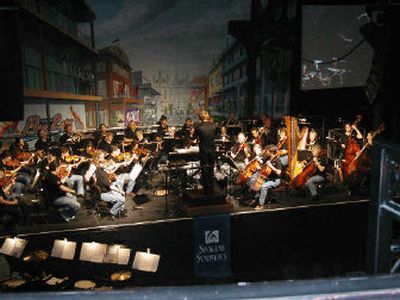Symphony loosens up for Big Easy show

The Spokane Symphony will again forsake Opera House formality for nightclub casual on Saturday when the orchestra returns to the Big Easy Concert House for another “Symphony on the Edge.”
This is the second season that Spokane audiences will have the chance to see symphony players get into more comfortable clothes while playing music that is out of the ordinary. And there will be two opportunities to do so this season, with another “Edge” coming in May.
Morihiko Nakahara, the orchestra’s associate conductor, will lead a program Saturday called “Dance Mix” which includes ballet music from opera, a work based on Haitian voodoo drumming, a piece of Russian Soviet-era jazz, and concert music by composers better known by their film scores.
“I’ve always had as my credo that all music must dance,” Nakahara says. “This is true even though my dancing is even worse than my golf, if that’s even possible.”
Nakahara sees the Big Easy’s nightclub setting as putting the audience at ease to hear a program combining traditional concert favorites with music that edges toward the slightly outrageous.
“This is really a whirlwind world tour that samples dance music of all kinds of cultures,” he says. “We’re opening with Beethoven’s overture to the ballet ‘The Creatures of Prometheus,’ but in just a few minutes we will be in the middle of a voodoo ritual in Christopher Rouse’s ‘Ogoun Badagris,’ a piece that calls for five percussionists playing 40 or 50 different instruments.”
The Spokane Symphony attracted national attention this summer when its “Symphony on the Edge” poster was used to illustrate a New York Times article on efforts by orchestras across the country to reach younger adults.
The Times article also called attention to the symphony’s offer of a free “Beethoven Bash” T-shirt to those under 30 who attend the orchestra’s Oct. 14 classics concert, which features Beethoven’s Third and Fifth Symphonies.
Last season’s “Symphony on the Edge” concert played to a standing-room-only audience. Longtime concertgoers and neophytes alike were curious to see orchestra players in jeans and polo shirts, shown in video close-ups on a big screen, illuminated by rock-concert lighting – and with refreshments readily available. (ID is required, please, for alcoholic drinks. And no smoking.)
“We could have gone to some more ‘pops concert’ programming,” Nakahara says, “but our real purpose was to attract people who may have not heard the orchestra before to an unusual place and some unusual music that still belongs to what we really do.”
The concert features composers well-known from the symphony’s Opera House performances: Beethoven, Bartok, Brahms, Bruch and Saint-Saens.
“But we have two composers whose music everyone has heard, but not in the concert hall,” says Nakahara. “Akira Ifukube was, for better or worse, associated with the music for the early `Godzilla’ movies, but we will play a movement from his ‘Ballata Sinfonica.’
“And Wojiech Kilar became really famous for his film score for ‘The Pianist’ and for ‘Dracula.’ But we will play ‘Orawa,’ an orchestral piece he wrote inspired by the shepherds’ dances from the mountains that separate Poland and Slovakia. Those shepherds get pretty wild toward the end.”
Other edgier works on Saturday’s program include Aturo Marquez’s Cuban-derived “Danzon No. 2” and Michael Daugherty’s flamenco-styled “Flamingo” – inspired, the composer claims, by the once-ubiquitous suburban icon, the pink plastic flamingo.